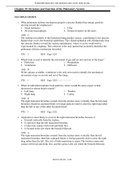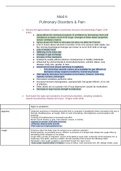Nolan study materials
study materials in all courses, exams, reviews, gismo, mathematics, revision notes, study guides, proctored e.t.c
- 72
- 0
- 1
Community
- Followers
- Following
73 items

Neuropsychology FINAL Exam (Lecture 19 - 25)-latest updates
Neuropsych FINAL Exam (Lecture 19 - 25) Class 19 Parietal lobe disorders Terms, concepts, processes 1. How are dizziness and vertigo different? o Vertigo is the circle feeling that the world is turning around you – this is something pretty nasty to be experiencing, while dizziness is something we all have previously experienced (e.g. when we haven’t eaten all day) --- usually associated with fainting which is preceded by light headedness o In both cases you can lose balance but verti...
- Exam (elaborations)
- • 22 pages •
Neuropsych FINAL Exam (Lecture 19 - 25) Class 19 Parietal lobe disorders Terms, concepts, processes 1. How are dizziness and vertigo different? o Vertigo is the circle feeling that the world is turning around you – this is something pretty nasty to be experiencing, while dizziness is something we all have previously experienced (e.g. when we haven’t eaten all day) --- usually associated with fainting which is preceded by light headedness o In both cases you can lose balance but verti...

Neuropsychology Exam: Assessing Human Brain Structure and Function ( UPDATED DETAILED SOLUTIONS)
Neuropsychology Exam 2 Review Assessing Human Brain Structure and Function Neuropsychological Research Methods - Main categories of research methods: o Examine the effects of brain damage o Correlate brain anatomy with behavior o Record brain activity during behavior o Examine the effects of stimulating particular parts of the brain Brain Pathology and Injury - Six main types o Tumors o Cerebrovascular accidents/ disorders o Infections o Neurotoxins o Closed-head injuries o Geneti...
- Exam (elaborations)
- • 19 pages •
Neuropsychology Exam 2 Review Assessing Human Brain Structure and Function Neuropsychological Research Methods - Main categories of research methods: o Examine the effects of brain damage o Correlate brain anatomy with behavior o Record brain activity during behavior o Examine the effects of stimulating particular parts of the brain Brain Pathology and Injury - Six main types o Tumors o Cerebrovascular accidents/ disorders o Infections o Neurotoxins o Closed-head injuries o Geneti...

PATHOPHYSIOLOGY: Structure and Function of the Pulmonary System QUESTIONS AND ANSWERS ( 8TH EDITION MCCANCE TEST BANK)
PATHOPHYSIOLOGY 8TH EDITION MCCANCE TEST BANK Chapter 35: Structure and Function of the Pulmonary System MULTIPLE CHOICE 1. What pulmonary defense mechanism propels a mucous blanket that entraps particles moving toward the oropharynx? a. Nasal turbinates c. Cilia b. Alveolar macrophages d. Irritant receptors on the nares ANS: C The submucosal glands of the bronchial lining produce mucus, contributing to the mucous blanket that covers the bronchial epithelium. The ciliated epithelial cel...
- Exam (elaborations)
- • 10 pages •
PATHOPHYSIOLOGY 8TH EDITION MCCANCE TEST BANK Chapter 35: Structure and Function of the Pulmonary System MULTIPLE CHOICE 1. What pulmonary defense mechanism propels a mucous blanket that entraps particles moving toward the oropharynx? a. Nasal turbinates c. Cilia b. Alveolar macrophages d. Irritant receptors on the nares ANS: C The submucosal glands of the bronchial lining produce mucus, contributing to the mucous blanket that covers the bronchial epithelium. The ciliated epithelial cel...

PATHO -THE PULMONARY SYSTEM
AGING AND THE PULMONARY SYSTEM Most knowledge about pulmonary structure and function is based on norms for the middle years. Less is known about structure and function in the very young (see Chapter 36) and older adults, but a few normal physiologic (developmental and degenerative) changes are known to occur from birth to old age. An understanding of these changes is needed to provide appropriate care and to differentiate between normal alterations and disease. Normal alterations include: (...
- Exam (elaborations)
- • 39 pages •
AGING AND THE PULMONARY SYSTEM Most knowledge about pulmonary structure and function is based on norms for the middle years. Less is known about structure and function in the very young (see Chapter 36) and older adults, but a few normal physiologic (developmental and degenerative) changes are known to occur from birth to old age. An understanding of these changes is needed to provide appropriate care and to differentiate between normal alterations and disease. Normal alterations include: (...

PATHO Mod 6 Pulmonary Disorders & Pain
Mod 6 Pulmonary Disorders & Pain 1. Discuss the aging related changes in pulmonary structure and physiology (Pages 1244- 1245). ● Aging affects the mechanical aspects of ventilation by decreasing chest wall compliance & elastic recoil of the lungs. Changes in these elastic properties reduce ventilatory reserve. ● Aging causes the PaO2 to decrease but does not affect the PaCO2. ● Less is known about structure & function in the very young & older adults, but few normal physiological...
- Exam (elaborations)
- • 16 pages •
Mod 6 Pulmonary Disorders & Pain 1. Discuss the aging related changes in pulmonary structure and physiology (Pages 1244- 1245). ● Aging affects the mechanical aspects of ventilation by decreasing chest wall compliance & elastic recoil of the lungs. Changes in these elastic properties reduce ventilatory reserve. ● Aging causes the PaO2 to decrease but does not affect the PaCO2. ● Less is known about structure & function in the very young & older adults, but few normal physiological...

Patho Study Guide Module 1
Study Guide Module 1 1. Differentiate genotype and phenotype. Are there any situations where a person’s genotype and phenotype are the same?(Beery & Workman, p.19-20; Pathophysiology, p. 135; 151) Genotype- the exact gene allele composition a person has for a specific single-gene trait is the person’s GENOTYPE for that trait. The composition of genes at a given locus. (Has the Brown hair gene). (having the PKU gene). Phenotype- is the person’s observed expression of any given single...
- Exam (elaborations)
- • 10 pages •
Study Guide Module 1 1. Differentiate genotype and phenotype. Are there any situations where a person’s genotype and phenotype are the same?(Beery & Workman, p.19-20; Pathophysiology, p. 135; 151) Genotype- the exact gene allele composition a person has for a specific single-gene trait is the person’s GENOTYPE for that trait. The composition of genes at a given locus. (Has the Brown hair gene). (having the PKU gene). Phenotype- is the person’s observed expression of any given single...

pathophysiology quiz 2.docx questions and answers
pathophysiology 1. Explain the role of normal microbiome as part of the innate protection against pathogenic microorganisms. (p. 300; p. 194) 1. Normal microbiome is the resident microorganisms found in different parts of the body, including the skin, mouth, gastrointestinal tract, respiratory tract and genital tract. 1. Example is the gut is provided with nutrients and it makes enzymes that help break down food. 2. Colon microorganisms contribute to innate protection by competing with ...
- Exam (elaborations)
- • 13 pages •
pathophysiology 1. Explain the role of normal microbiome as part of the innate protection against pathogenic microorganisms. (p. 300; p. 194) 1. Normal microbiome is the resident microorganisms found in different parts of the body, including the skin, mouth, gastrointestinal tract, respiratory tract and genital tract. 1. Example is the gut is provided with nutrients and it makes enzymes that help break down food. 2. Colon microorganisms contribute to innate protection by competing with ...

Final Quiz-ATI Gerontology (detailed solutions)
A nurse is completing medication reconciliation for an older adult client who is receiving multiple medications. Which of the following actions should the nurse take first? A- Clarify the client list of medications with the pharmacist B- compare the current list against the new medication prescriptions C- investigate any discrepancies on that list D- ask the client about over the counter medications she is taking Answer- D The nurse should apply the nursing process priority-setting frame...
- Exam (elaborations)
- • 7 pages •
A nurse is completing medication reconciliation for an older adult client who is receiving multiple medications. Which of the following actions should the nurse take first? A- Clarify the client list of medications with the pharmacist B- compare the current list against the new medication prescriptions C- investigate any discrepancies on that list D- ask the client about over the counter medications she is taking Answer- D The nurse should apply the nursing process priority-setting frame...

MATERNITY PROCTORED EXAM-ATI
ATI MATERNITY PROCTORED EXAM VERSION 1 A nurse in an antepartum clinic is assessing a client who has a TORCH infection. Which of the following findings should the nurse expect? (SATA) A. Joint pain. B. Malaise. C. Rash. D.Urinary frequency. E. Tender lymph nodes. A. Ceftiaxone. A nurse is caring for a client who has gonorrhea. Which of the following medications should the nurse anticipate the provider will prescribe? A. Ceftiaxone. B. Fluconazole. C. Metronidazole. D.Zidovudine. A....
- Exam (elaborations)
- • 9 pages •
ATI MATERNITY PROCTORED EXAM VERSION 1 A nurse in an antepartum clinic is assessing a client who has a TORCH infection. Which of the following findings should the nurse expect? (SATA) A. Joint pain. B. Malaise. C. Rash. D.Urinary frequency. E. Tender lymph nodes. A. Ceftiaxone. A nurse is caring for a client who has gonorrhea. Which of the following medications should the nurse anticipate the provider will prescribe? A. Ceftiaxone. B. Fluconazole. C. Metronidazole. D.Zidovudine. A....

RN Comprehensive Predictor Remediation-ATI latest updates
ATI RN Comprehensive Predictor Remediation Management of Care Assignment, Delegation and Supervision Managing Client Care: Assignment to Delegate to a Float Nurse ● The float nurse should be assigned to patients she has experience with similar client types to those patients. ● The assignment should take into account the level of familiarity the nurse has of the unit she is on. ● If the nurse feels that her assignment is unsafe she should speak to the charge nurse about her concern...
- Exam (elaborations)
- • 9 pages •
ATI RN Comprehensive Predictor Remediation Management of Care Assignment, Delegation and Supervision Managing Client Care: Assignment to Delegate to a Float Nurse ● The float nurse should be assigned to patients she has experience with similar client types to those patients. ● The assignment should take into account the level of familiarity the nurse has of the unit she is on. ● If the nurse feels that her assignment is unsafe she should speak to the charge nurse about her concern...
